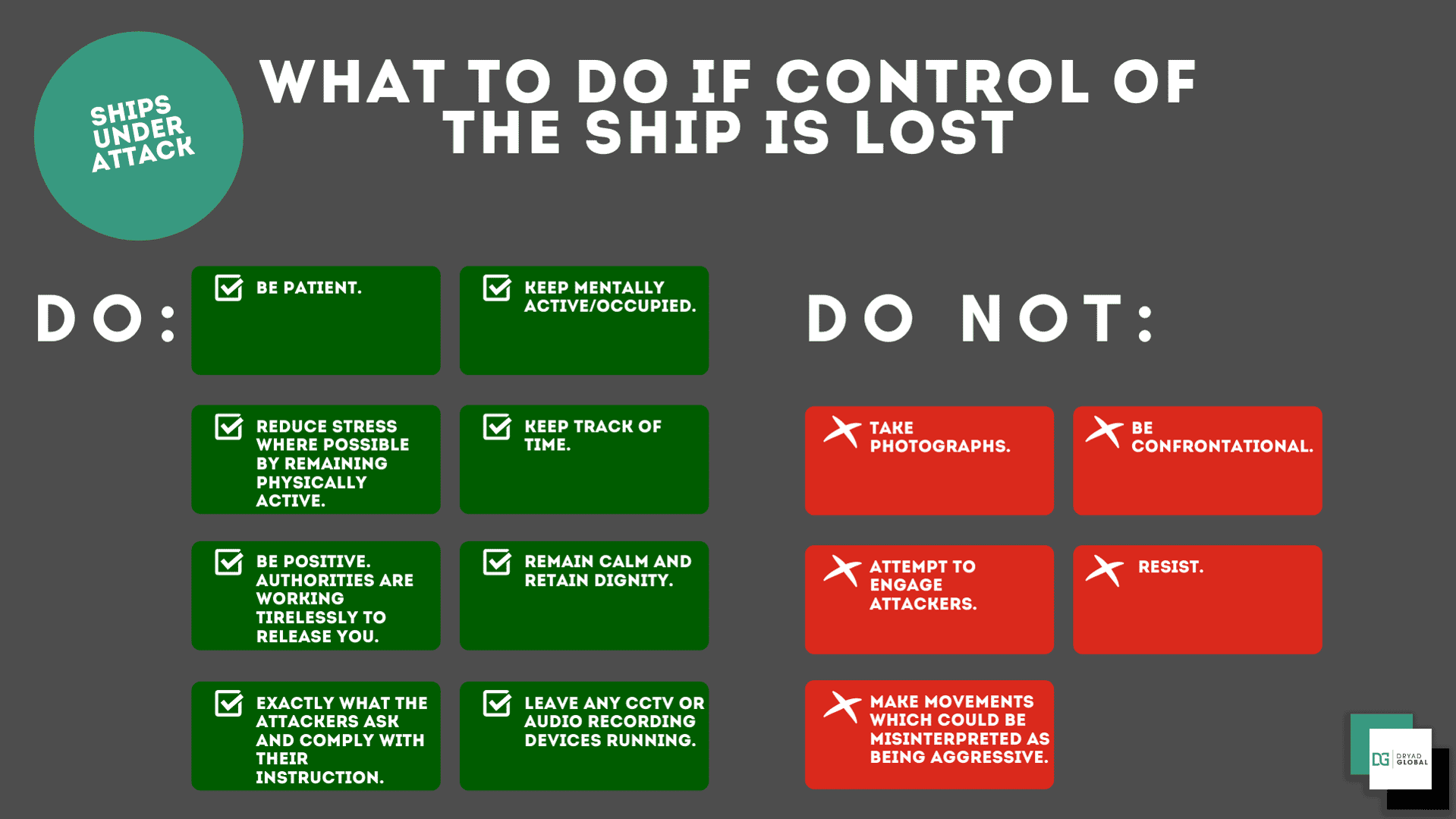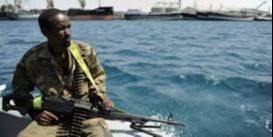BMP5 - Ships Under Attack Guidelines
Piracy Attack
Use whatever time available, no matter how short, to activate any additional protective measures and plans. This will make it clear to the attackers that they have been seen, the ship is prepared and will resist attempts to board.
In the event of a suspicious approach, or if in any doubt, call UKMTO without delay.
You might be interested in Piracy in Maritime Law
Approach Stage
Effective lookouts may aid in identifying the nature of the attack, the threat profile of a piracy or other attack may initially look similar and it will not be until the attackers are close that the nature of the attack becomes apparent. In all cases, the following steps should be taken:
- If not already at full speed, increase to maximum to open the distance.
- Steer a straight course to maintain a maximum speed.
- Initiate the ship’s emergency procedures.
- Activate the emergency communication plan.
- Sound the emergency alarm and make an attack announcement, in accordance with the ship’s emergency communication plan.
- Make a mayday call on VHF Ch. 16. Send a distress message via the Digital Selective Calling (DSC) system and Inmarsat-C, as applicable.
- Activate the SSAS.
- Report the attack immediately to UKMTO (+44 2392 222060) by telephone.
- Ensure the AIS is switched on.
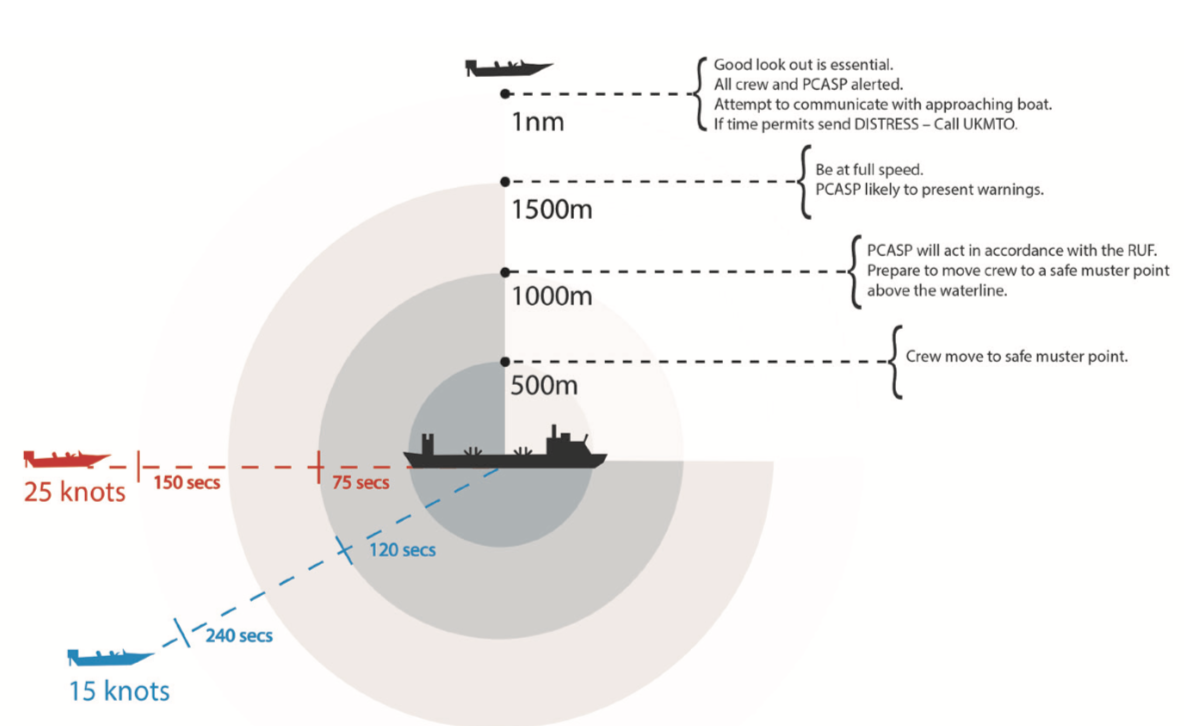
- Activate water spray.
- Ensure that all external doors and, where possible, internal public rooms and cabins are fully secured.
- All crew not required on the bridge or in the engine room should muster at the safe muster point or citadel as instructed by the Master.
- When sea conditions allow, consider altering course to increase an approaching skiff’s exposure to wind/ waves.
- Sound the ship’s whistle/foghorn continuously to demonstrate to any potential attacker that the ship is aware of the attack and is reacting to it.
- Check Vessel Data Recorder (VDR) is recording.
- PCASP, if present, will take agreed actions to warn off attackers.
Attack Stage
As the attackers get close the following steps should be taken:
- Reconfirm all ship’s crew are in the safe muster point or citadel as instructed by the Master.
- Ensure the SSAS has been activated.
- If not actioned, report the attack immediately to UKMTO (+44 2392 222060) by telephone.
- As the attackers close in on the ship, Masters should commence small alterations of helm whilst maintaining speed to deter skiffs from lying alongside the ship in preparation for a boarding attempt. These manoeuvres will create additional wash to impede the operation of the skiffs.
- Large amounts of helm are not recommended, as these are likely to significantly reduce a ship’s speed.
- Check VDR data is being saved.
- PCASP, if present, will conduct themselves as governed by the RUF.
- Actions on illegal boarding
- If the ship is illegally boarded the following actions should be taken:
- Take all way off the ship and then stop the engines.
- All remaining crew members to proceed to the citadel or safe muster point locking all internal doors on route.
- PCASP, if present, will follow procedures agreed with company and Master.
- Ensure all crew are present in the citadel or safe muster point. This includes the Master, bridge team and PCASP.
- Establish communications from the citadel with UKMTO and your company and confirm all crew are accounted for and in the citadel or safe muster point.
- Stay in the citadel until conditions force you to leave or advised by the military.
- If any member of the crew is captured it should be considered that the pirates have full control of the ship.
If control of the ship is lost
Hijack – hostage situation
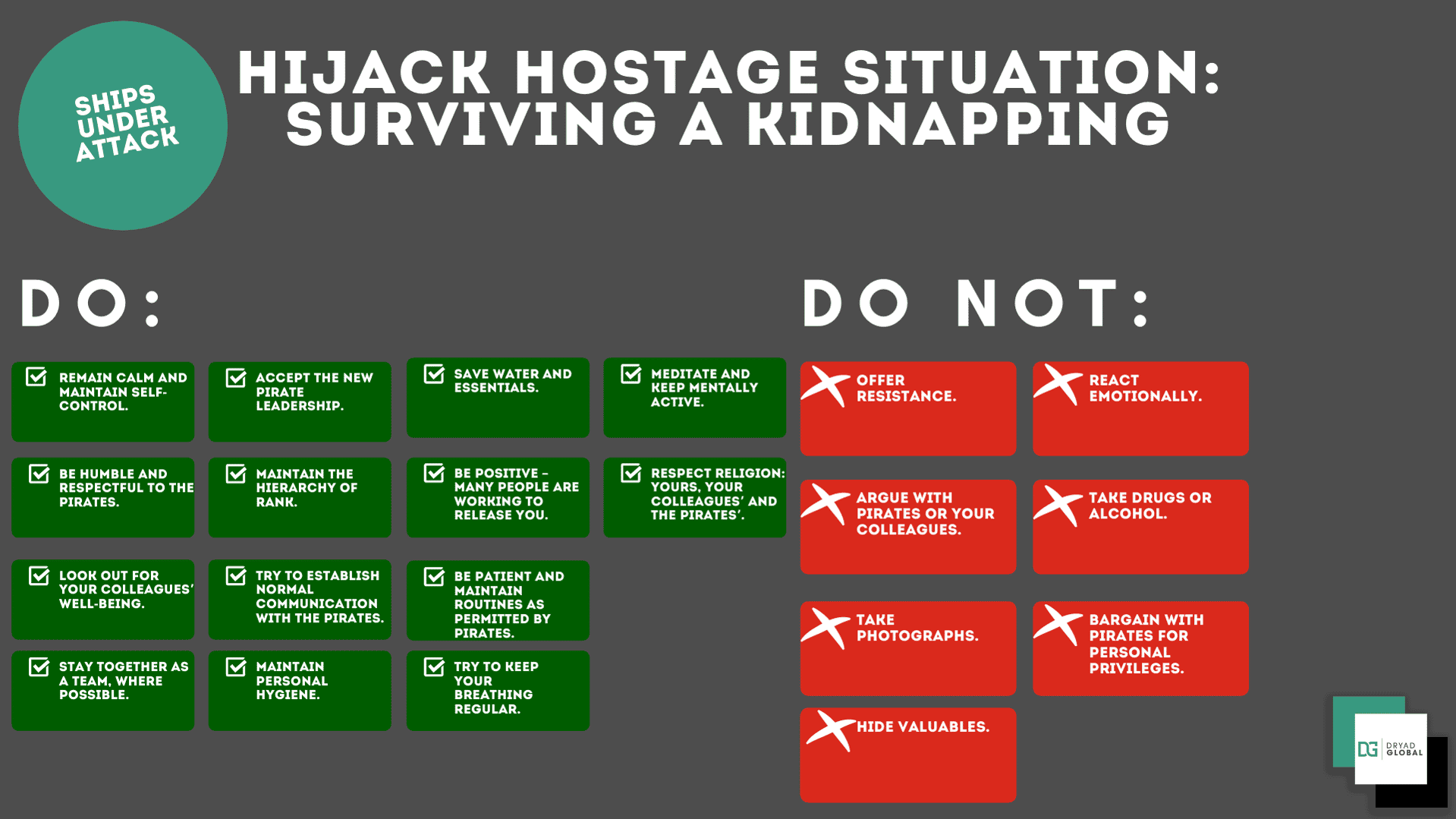
The model of pirate action groups, particularly off West Africa is to hold the crew for ransom. It should be remembered it is in the interests of the pirates to keep the crew in such a condition so as to ensure ransom payment.
Each company or organisation should have a policy in place to cover the eventualities of kidnap and ransom.
The following principles serve as guidelines to surviving a kidnapping.
DO
- Keep low to the deck and cover head with both hands.
- DO keep hands visible.
- DO be prepared to be challenged on your identity.
- DO cooperate fully with military forces.
DO NOT
- DO NOT make movements that could be interpreted as aggressive.
- DO NOT take photographs.
- DO NOT get involved in activity with military forces unless specifically instructed to.
Anti-Ship Missiles
In the event or warning of a missile attack military advice should be followed. If no warning is received there will be no time to take any mitigation beyond
a PA warning to the crew if a missile is spotted. It is unlikely merchant ships will be the intended target; Masters should be aware of the ship plot in their immediate vicinity and, if sea room allows, keep clear of naval and associated ships.
Sea Mines
Ships should avoid all published or identified mine danger areas and maintain close liaison with military authorities. If operating close to mine danger areas, Masters should be aware tethered mines may break free and drift into shipping lanes. Ships should manoeuvre clear of floating objects and the forward area of the ship should be kept clear of crew. Effective lookouts are essential. Specific advice on self protective measures when operating in mine danger areas can be obtained from UKMTO.
WBIED Attack
In the early stages of the attack it may not be possible to differentiate between a piracy or WBIED attack. Initial actions as highlighted in this guidance for the approach stage of a piracy attack should be followed. Military threat assessments may indicate areas where one type of attack is more likely than another. A speed boat with multiple people onboard is unlikely to be a WBIED as these are usually unmanned or have a solitary occupant. WBIED attacks may result in a breach of the ship’s hull. The use of the safe muster point is recommended before entering a citadel located below the waterline. If a WBIED is anticipated, the time to react is very short. The figure below gives an example of possible reaction times.
The threat and risk assessment will identify areas where these threats occur which, if successful, may result in an explosion (commonly referred to as a blast). The Master should communicate to the crew prior to entering a threat area what position to take if a blast threat is detected.
The Master may consider telling the crew to:
- Lie flat on the deck, as this may minimise exposure and may reduce the impact on the body from the blast.
- Adopt a brace position (arms/legs bent, hands holding onto something solid and feet firmly planted on the deck) to protect personnel from shock waves.
- Move away from a particular area, such as the port side, starboard side, poop deck or engine room.

Post WBIED Attack
Ensure all crew and PCASP are accounted for.
- Send distress signal.
- Survey area where the blast occurred.
- Implement damage control.
- Call CSO and UKMTO.
Post Attack Investigation
Thorough investigation using all available evidence is critical.
The quality of the evidence provided and the availability of the crew to testify will significantly help any investigation or prosecution that follows.
Following any attack or incident the investigating authority will be determined by external factors including:
- Flag State.
- Ownership.
- Crew nationality.
The lead law enforcement agency will talk to the Master and crew to understand the sequence and circumstances of the event.
In a post hostage situation, law enforcement authorities may ask to conduct post-release crew debriefs and to collect evidence for investigations and prosecutions following captivity.
Advice

INTERPOL has a secure website to provide support to ship operators who have had their ships hijacked. INTERPOL’s Maritime Task Force can assist in taking the appropriate steps to preserve the integrity of the evidence left behind at the crime scene. INTERPOL has a Command and Co-ordination Centre (CCC) that supports any of the 188-member countries faced with a crisis or requiring urgent operational assistance. The CCC operates in all four of INTERPOL’s official languages (English, French, Spanish and Arabic) and is staffed 24 hours a day, 365 days a year. It is recommended that ship operators contact INTERPOL within three days of a hijacking of their ship.
INTERPOL may also be consulted to discuss the recommended practices for the preservation of evidence that could be useful to law enforcement agents pursuing an investigation.
Contact details are: email os-ccc@interpol.int; telephone +33 472 44 7676.
Seafarer Welfare

Seafarers and their families often have difficulty in expressing the need for assistance or even recognising that they need assistance following exposure to a security threat. The company should monitor the health, both physical and mental, of those exposed to piracy and other maritime security threats and if necessary provide independent support and other assistance, as may be appropriate.
There is a range of humanitarian programmes aimed at assisting seafarers and their families effected by piracy or maritime crime, including the International Seafarers Welfare and Assistance Network and The Mission to Seafarers. See www.seafarerswelfare.org and www.missiontoseafarers.org.

Maritime Security Threats
As well as piracy, regional instability has introduced new security threats including the use of; anti-ship missiles, sea mines and Water-Borne Improvised Explosive Devices (WBIED).
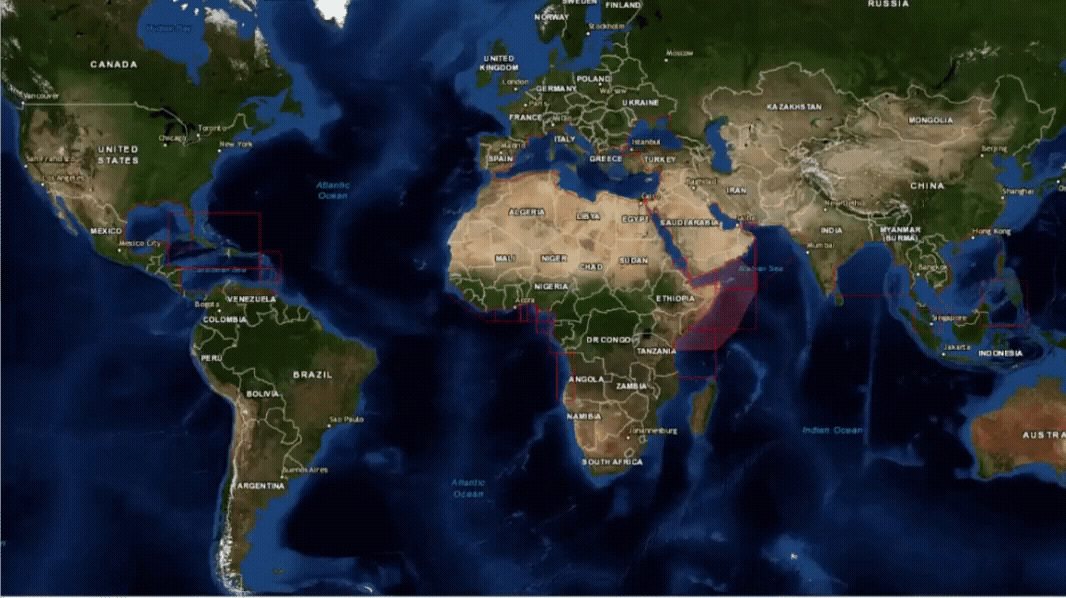
Maritime Security Geographical Regions
Where are the current hotspots that warrant the application of BMP5?
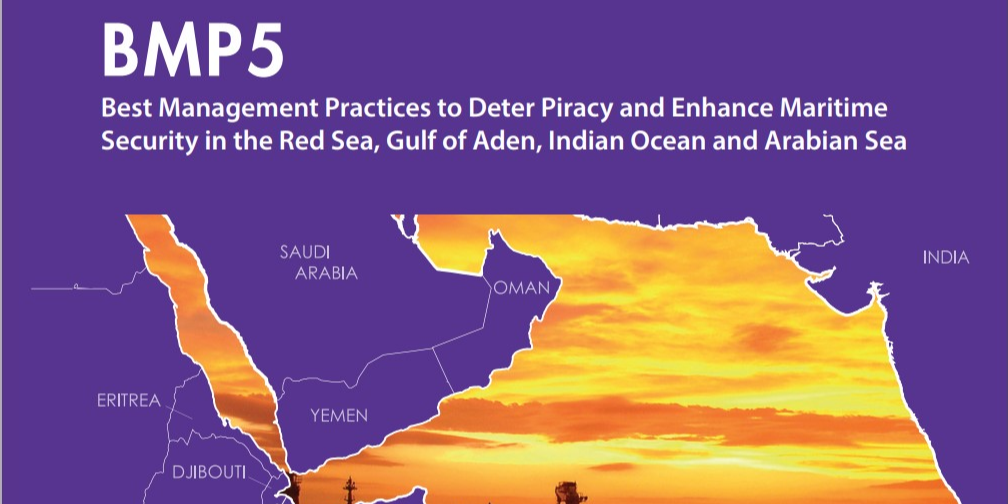
Threat and Risk Assessment
What is a security risk assessment? The threat assessment must include all regional security threats.
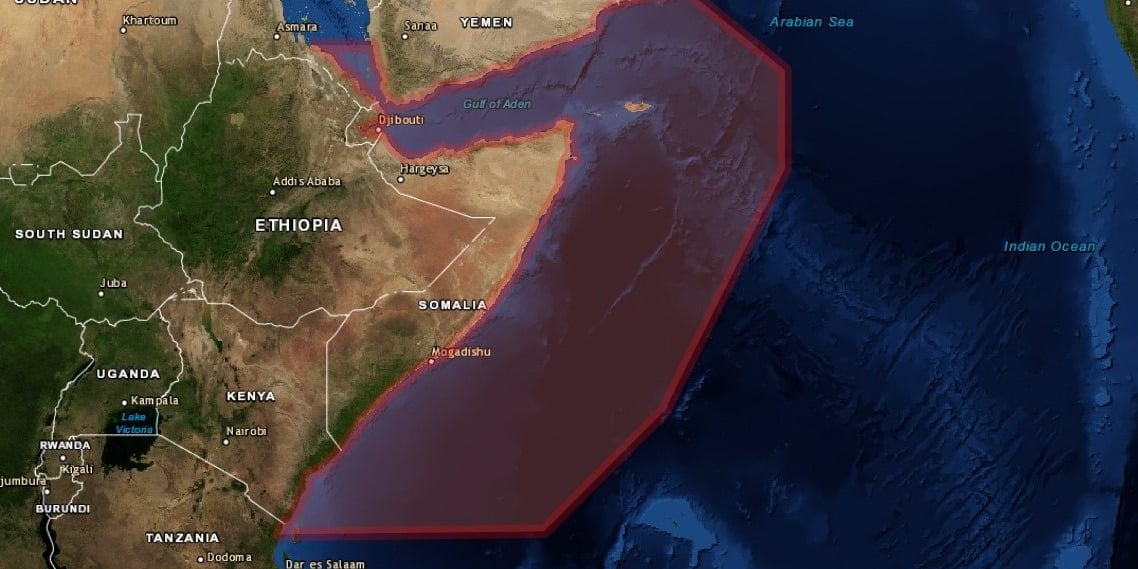
Voyage Planning
The output of the risk assessment will help develop the ship's voyage plan.
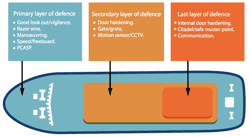
Ship Protection Measures
BMP5 provides Ship Protection Measures (SPM) based on real-life experience of piracy attack and incidents of maritime crime.

Reporting Guidelines
All ships are strongly encouraged to inform military organisations of their movement


